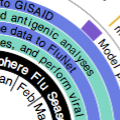Abstract
Seasonal influenza is controlled through vaccination campaigns. Evolution of influenza virus antigens means that vaccines must be updated to match novel strains, and vaccine effectiveness depends on the ability of scientists to predict nearly a year in advance which influenza variants will dominate in upcoming seasons. In this review, we highlight a promising new surveillance tool: predictive models. Developed through data-sharing and close collaboration between the World Health Organization and academic scientists, these models use surveillance data to make quantitative predictions regarding influenza evolution. Predictive models demonstrate the potential of applied evolutionary biology to improve public health and disease control. We review the state of influenza predictive modeling and discuss next steps and recommendations to ensure that these models deliver upon their considerable biomedical promise.
